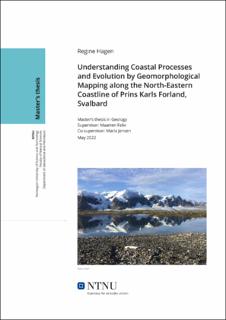| dc.description.abstract | During the last 100 years a rise in temperature, especially during winter, has been observed in the Arctic. As a result, glaciers retreat, the active layer of permafrost increases in depth, the open water season becomes longer, and storms become stronger and more frequent. All these changes affect and will continue to affect Arctic coastlines. To improve the understanding of Arctic coastline changes of Prins Karls Forland, Svalbard, field observations and the study of aerial photos and satellite images from 1936, 2008 and 2021 were combined to map the geomorphological and sedimentological features and changes. Fieldwork was carried out at 8 localities on the north-eastern shore of Prins Karls Forland during the summer of 2021. Grain size data, landform descriptions, vegetation cover descriptions and samples for 14C dating were collected during the fieldwork. At each locality, landforms (as seen in the field) and their changes (as seen from satellite images) were used to identify the processes controlling shoreline morphology (wave action, tides, coastal currents, …). The combined fieldwork/ image analysis showed that the main process controlling shoreline morphology is wave action due to incoming swells/ waves from the north. The main process is however overprinted at Selvågen and Brebukta by tidal influence and terrestrial processes in sheltered bays and recently deglaciated areas. The future development of the north-eastern coastline of PKF is predicted on the basis of current processes observed and climatic trends. Coastal sections that are sheltered from strong swells/ waves will likely prograde as terrestrial processes and paraglacial sedimentation provide sediment, while coastal features found along wave exposed coasts will likely migrate landwards due to increased storminess. | |
